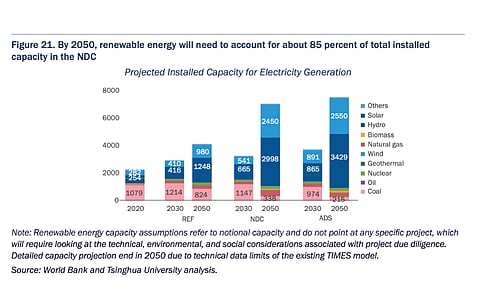

A new World Bank analysis recommends China to expand its 2030 wind and solar target to 1.7 TW, from 1.2 TW now—leading to up to 120 GW annually till 2030—which could advance its emissions peaking to earlier than 2030 and lead to a significant reduction in cumulative emissions
Annual wind and solar PV additions of around 120 GW will be 1.5 times the annual average during 2016-20 and 20% more than it added in 2021 (see China NDC For 1.2 TW Wind & Solar By 2030).
"This would enable China to meet incremental electricity demand with renewable energy and reduce coal-based generation from 2025 onwards. This is an ambitious target. Achieving it would require a strong global supply response and increased production capacity for battery and solar/wind components to reduce pressure on prices for these technologies," notes the bank in its Country Climate and Development Report (CCDR) for China.
Under the government's Nationally Determined Contributions (NDC), China's installed capacity of wind and solar PV are likely to reach over 5,000 GW in 2050, but under an accelerated decarbonization scenario (ADS), their combined share should increase to around 6,000 GW.
As per the report, China is well positioned to meet its climate commitments and transition to a greener economy while meeting its development goals but faces significant threat from climate change. It is especially vulnerable to climate change impacts for its economically critical low-lying coastal cities that house around 1/5th of the country's population and are also responsible for 1/3rd of its national GDP. "Unabated climate change could lead to estimated GDP losses of between 0.5% and 2.3% as early as 2030," cautions the bank.
Hence it becomes critical for the Asian giant to successfully transition to a low-carbon economy without which 'achieving global climate goals will be impossible'.
The country aims to reach net-zero emissions by 2060, and for this the report expects it to need $14 trillion to $17 trillion additional investments for green infrastructure and technology in the power and transport sectors alone.
"Given the immense price tag, public investments won't be sufficient to meet these needs, so China needs policy and regulatory reforms to spur the private sector and fully tap the potential for investment and innovation," said International Finance Corporation's (IFC) Regional Vice President for Asia and the Pacific, Ruth Horowitz.
The good news is China has an opportunity to turn climate change into an opportunity, as per the report writers, as it can increase returns on the production and development of low-carbon technologies as wind and electricity storage, its leadership position in green finance and the ability to create high-skilled jobs in high-productivity industries. It would require participation from the private sector, working in tandem with the public sector.
Along with expanding the 2030 wind and solar installed capacity goal by over 40% to 1.7 TW from 1.2 TW as one of the policy priorities for the country, the bank recommends China to support this renewable energy with additional energy storage of 200 GW and ensure a more flexible electricity grid.
Analysts want the government to expedite electricity market reforms including pricing reforms, development of ancillary service and capacity markets along with encouraging interprovincial power trade. It must also promote measures related to energy efficiency, distributed renewable energy and demand response programs.
To ensure decarbonization of key energy demand sectors as transport and industry, the recommendation is to accelerate electrification. Among other recommendations is the need to have Chinese lenders to adopt clean financing principals and operationalize the phasing out of financing of coal and other carbon-intensive infrastructure.
Complete report is available for free download on the World Bank's website.
The CCDRs are the World Bank's new 'core diagnostic reports aimed at helping countries prioritize the most impactful actions to reduce GHG emissions while achieving their broader development goals.
.png?w=50&fm=png)